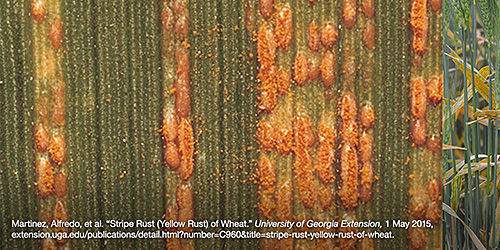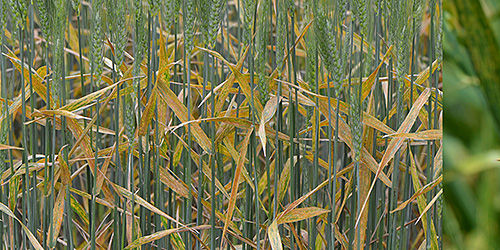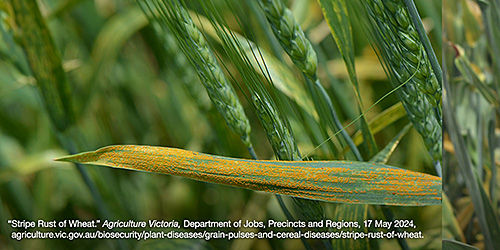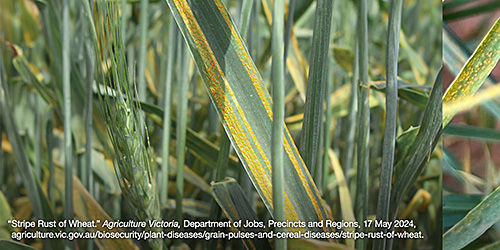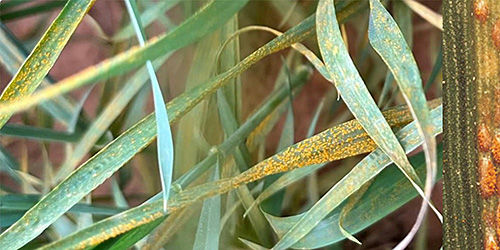Wheat Rust Diseases
July 8, 2024
Rust diseases represent the most economically significant fungal diseases in wheat and other cereal crops worldwide, and they are widely distributed across wheat-growing regions. The three rust diseases affecting wheat are leaf, stem, and stripe rust.
Stripe Rust
Identification and lifecycle
Stripe rust, also known as yellow rust, is caused by the fungus Puccinia striiformis f. sp. tritici. The disease primarily occurs on leaves, although glumes and awns may also be affected. This part of the lifecycle leads to “hot spots” of infection seen in crops in later winter and early spring.
In lower humidity, stripe rust spores disperse more freely into the air and can travel for much greater distances. This may result in a uniform pattern of disease development beginning in mid-spring.
In recent years, stripe rust has become more common in the Great Plains states. It reached high levels in early spring 2015 due an unusually wet spring across most of the region.
Stripe rust appears earlier in the season because development is enhanced by the cool, moist weather early in the growing season, versus leaf rust, which is more prevalent later in the spring when temperatures warm. Stripe rust develops under ideal temperatures of 45 to 54 degrees F with six to eight hours of leaf moisture.
Stripe rust typically produces yellow or orange blister-like pustules that are arranged in stripes. The lesions produce massive amounts of spores that are easily dislodged and dispersed by wind. The spores may leave orange dust on the clothing of individuals walking through heavily infected fields.
When stripe rust spores land on a living wheat leaf, germination and infection can result. Growing inside the leaf, stripe rust produces new lesions containing new spores. Under high-humidity conditions during winter, most spores survive in small clumps that are relatively heavy and fall quickly out of the air when dispersed. As a result, spores spread mostly over short distances and may appear in uniform patterns of disease seen in mid-spring. Several cycles of spore production occur throughout the growing season.
Crop Damage
According to the University of Nebraska, it’s possible for stripe rust to cause 100 percent crop loss in susceptible varieties if the disease begins early in the season under wet, cool weather conditions.
Leaf Rust
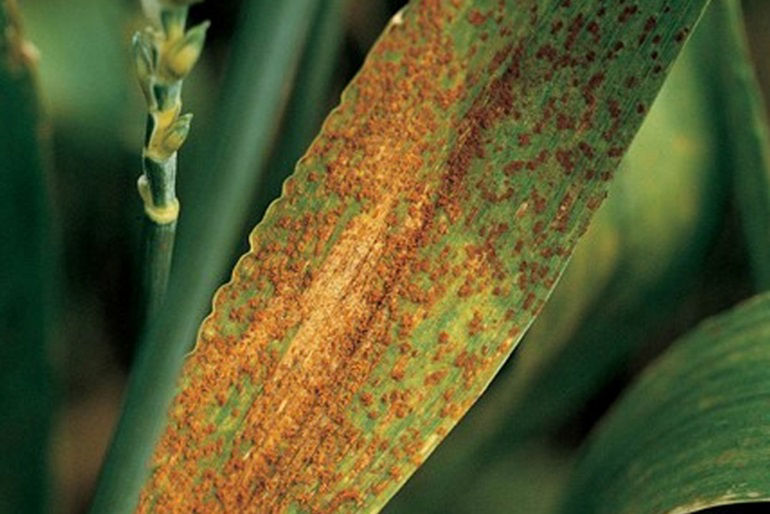
Identification and lifecycle
Leaf rust, also known as brown rust, is caused by the fungus Puccinia triticina. This rust disease occurs wherever wheat, barley and other cereal crops are grown. Leaf rust attacks foliage only. Identifying symptoms are dusty, reddish-orange to reddish-brown fruiting bodies that appear on the leaf surface. These lesions produce numerous spores, which can cover nearly the entire upper leaf surface.
Leaf rust spores are spread by wind and splashing water. Optimal environmental conditions for development of infection are temperatures ranging from 59 to 68 degrees F and at least six hours of moisture on the leaf surface. With wet weather and ideal temperatures, lesions are formed within seven to 10 days of infection, and spore production repeats another disease cycle. Leaf rust fungi survive to overwinter in wheat crops in southern states. These overwintering fungi develop spores in the spring, which are blown north to infect wheat in the Great Plains and Midwest states.
Crop Damage
Leaf rust causes the most damage when severe rusting covers the upper leaves before flowering. Early defoliation can occur, reducing time for grain fill and leading to the creation of smaller kernels. Grain shrivels, and any nutrients produced – primarily in the flag leaf – are used by the fungal infection instead of being transported to the grain. Early infection can result in weak plants and poor root and tiller development.
Significant yield losses can occur from leaf rust disease. The University of Nebraska reports that in the Great Plains, severe epidemics have caused yield losses of up to 14 percent. In some areas they have even surpassed 50 percent, depending upon weather conditions, disease development early in the growing season and variety susceptibility.
Grain test weight and yield damage correlates to the level of disease infection and how early in the season wheat leaf rust disease attacks. North Dakota State University research reports 30 to 40 percent yield losses when infection becomes severe prior to flowering, with flag leaf damage exceeding 60 percent and, in some cases, up to 100 percent.
Stem Rust
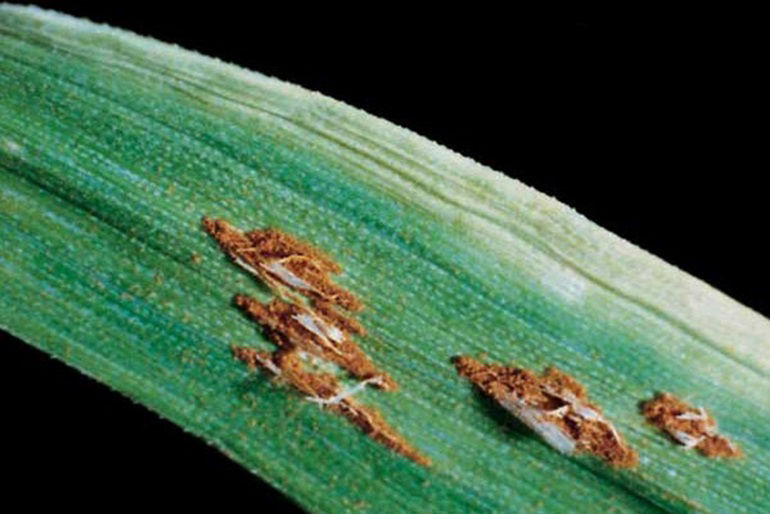
Identification and lifecycle
Stem rust, also known as black rust, is caused by the fungus Puccinia graminis f. sp. tritici. It infects wheat and other cereals across all U.S. growing regions. Stem rust occurs when raised spots (pustules) form on stems and leaf sheaths, although occasionally they may form on awns, glumes and seeds.
Stem rust spots appear elliptical and differ from leaf and stripe rust in that they are more elongated. The spots form on both lower and upper leaf surfaces and look orange to dark-red in color. The margins on stem rust spots are ragged. Young pustules release numerous spores. Later in the growing season, spores transform and become dark colored, hence the common name of black rust.
Stem rust development requires the warmest temperatures of the three wheat rusts –ideally 59 to 84 degrees F and six to eight hours of moisture on the leaf surface. With wet weather and optimal temperatures, new lesions are formed in seven to 10 days. Stem rust disease also spreads spores through wind dispersal and splashing water. Spores are produced in multiple cycles during the growing season.
Overwintering spores that develop in the previous year’s wheat crop late in the season survive to produce additional spores, which spread via wind to infect wheat. Thus, another lifecycle is completed. In most U.S. growing regions, the primary source of stem rust infection in wheat is repeated spore production.
Crop Damage
The disease spreads rapidly and can travel long distances by wind or other means of transportation such as farm equipment or plant materials. With severe infections, the disease can turn a healthy crop into a tangle of black stems only weeks away from harvest, resulting in shriveled grain. According to the United Nations Food and Agriculture Organization (FAO), stem rust can result in 70 percent or more loss in wheat yield.
While stem rust has historically been the most damaging disease of wheat, it’s not as prevalent today thanks to resistant varieties.
Managing Wheat Rusts
Farmers have several options to manage wheat rusts, including seed treatments, variety selection, scouting, cultural practices and fungicide applications.
Seed treatments
Using the correct fungicide seed treatment and rate is one way to provide effective and economical disease control in wheat production. Seed treatments protect seed and young plants from disease and other threats to plant health and yield. Areas commonly infested with rust also will need a foliar fungicide treatment to provide protection beyond the seedling growth stage.
Variety selection
Where available, use rust-resistant varieties for best protection against leaf rusts. Every commercially available wheat variety has a unique disease package, and excellent disease resistance is not available to manage all disease threats in high-yielding varieties. It’s best to select two or three high-yielding varieties that offer the best resistance to common diseases found on your individual farm.
Scouting
When scouting for weeds and insects, check for the presence of wheat rusts and other diseases. Monitor reports of wheat rust development occurring in states south of your area. This will allow you to track the progression of rust diseases migrating north from overwintering hosts and will also help you predict the timing and severity of infestations before they might affect your region. Keep a close eye on weather conditions because rust spores spread through wind currents to promote disease infection.
If you suspect leaf rust, stem rust or stripe rust infection, take samples and work with your county Extension agent to confirm a diagnosis. Crop identification guides are also helpful. Scouting helps determine levels of infection so you can make the best decision about the necessity and rate of fungicide applications.
Cultural practices
Disease-free seed gives seedlings a good start. Good weed control preplant, at planting and throughout the growing season also helps protect against disease and other pests.
Fungicides
Good control of wheat rusts can be achieved with commercially available fungicides and proper application timing. The decision to use fungicides should be based on scouting for symptoms. It’s important to assess disease severity from the onset of infection through the various growth stages. Application timing should take into consideration that diseases should be managed before infection reaches the upper leaves. Other factors affecting fungicide application are infection levels in the field, the susceptibility of the variety and the market price for wheat grain.
Crop Science Solutions to Prevent Wheat Rusts
A well-thought-out disease-management program, including best management practices, proper seed protection and selection and fungicide applications using multiple modes of action, should be implemented to sustainably manage diseases. The following Crop Science solutions are valuable tools to consider for your program.
Because cereal fungal diseases can overwinter and survive in crop residue, crop rotations that include dicot crops can help reduce the inoculum of fungal leaf spot pathogens. Fungicide seed treatments can provide a healthy start for seedlings, especially in cool and damp spring conditions. EverGol® Energy from Crop Science is a seed treatment fungicide that promotes more root growth for faster crop establishment and controls seed and soil-borne disease such as Rhizoctonia. It features a new combination of fungicides incorporating a complementary mode of action that supports resistance management.
A number of fungicides are available for both early-season and late-season control of these common leaf diseases. Chemistries from two of the most commonly used classes of fungicides – triazoles and strobilurins – provide good to excellent activity against wheat leaf diseases and, when used in conjunction with best management practices, can help manage disease resistance. Wheat growers should consider fungicides with systemic movement and curative properties for the broadest protection from cereal foliar diseases.
Prosaro® PRO pairs powerful preventive and curative disease control with long residual activity for consistent performance across a variety of growing conditions against key cereal leaf diseases such as various types of rust, Septoria leaf blotch, tan spot and powdery mildew. Additionally, Prosaro PRO provides unsurpassed activity against head diseases such as scab (Fusarium head blight). It’s a good choice to ensure grain health and enhance yield potential.
For more information on wheat disease control options from Bayer, please contact your local Crop Science representative or visit the cereals section.
Before selecting a seed treatment or applying any fungicide, please read the entire label for the best possible results and to confirm that the product is effective on the disease you need to control. Not every product is suitable for every situation, and correct application technique will ensure the best results.
Read More About Disease Control
ALWAYS READ AND FOLLOW PESTICIDE LABEL DIRECTIONS.
Not all products are registered for use in all states and may be subject to use restrictions. The distribution, sale, or use of an unregistered pesticide is a violation of federal and/or state law and is strictly prohibited. Check with your local dealer or representative for the product registration status in your state. Bayer, EverGol® and Prosaro® are registered trademarks of Bayer Group. For additional product information call toll-free 1-866-99-BAYER (1-866-992-2937) or visit our website at www.BayerCropScience.us. Bayer CropScience LP, 800 North Lindbergh Boulevard, St. Louis, MO 63167. ©2024 Bayer Group. All rights reserved.
